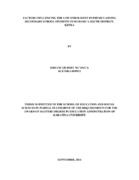| dc.description.abstract | Kenyan Secondary school students in form one and two are exposed to a broad curriculum that comprises of eleven or more examinable subjects. Towards the end of form two, the
students are given an opportunity to reduce the number of these subjects to a minimum of
seven. By so doing, they are given the opportunity to make their choices from a group of
optional subjects, which include Physics. It has been observed that Physics has been faced
with declining popularity amongst the students leading to low students’ enrolment both in
Murang’a South District and also at the national level when compared with other optional
subjects. In the year 2012 only 31% of the students registered for KCSE within the country
had chosen Physics while in Murang’a South only 32.5 % had selected it. The main
objective of this study was to investigate how the low enrolment in Physics is influenced by
student related factors, subject teacher, parents and availability of physical resources in a
given school. In carrying out the study, the researcher was guided by Atkinson’s
achievement motivation theory. The study employed descriptive survey research design. It
was carried out in 4 public secondary schools within the Murang’a South District. The
respondents included 4 secondary school principals, 4 physics teachers and 64 students
giving a total of 72 respondents. Sampling of the schools was done in a way that ensured
representation of single gender schools and mixed schools. The students sample was drawn
from the form threes and the form fours. The research instrument used was a questionnaire.
To establish the validity of the research instrument, the researcher involved experts in
research, mainly the supervisors and lecturers of Karatina University. Reliability of the
research instrument was established through piloting. The data obtained was subjected to
test retest technique, out of which the reliability coefficient was computed and found to be
0.82. The research instruments were then proved to be reliable. Data was then analyzed
and interpreted. The results obtained indicated that student related factors such as peer
pressure and attitudes contribute to low enrolment in Physics. The low enrolment was also
found to have been influenced by the subject teacher. Findings from the study indicated that
the parents and physical facilities have little or no influence in the low enrolment. The
study therefore recommended that peer influence should be discouraged among the students
while teachers’ workshops and seminars should be organized to educate them on how to
uplift the enrolment in Physics. It was further recommended that the parents should be
brought on board regarding subject choices. | en_US |
